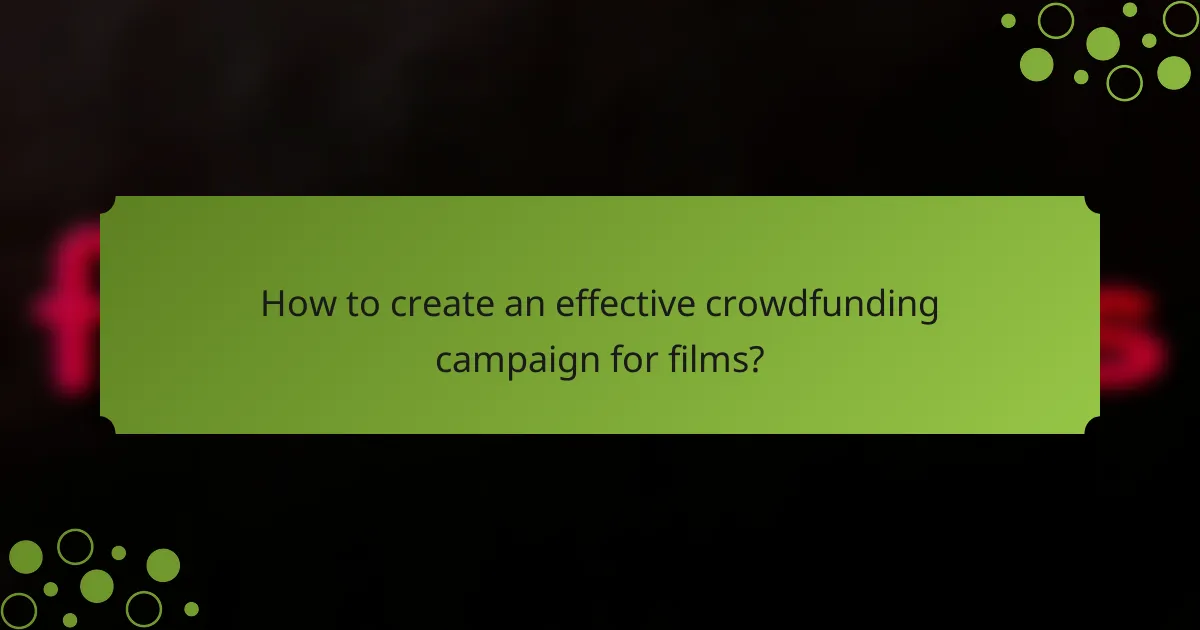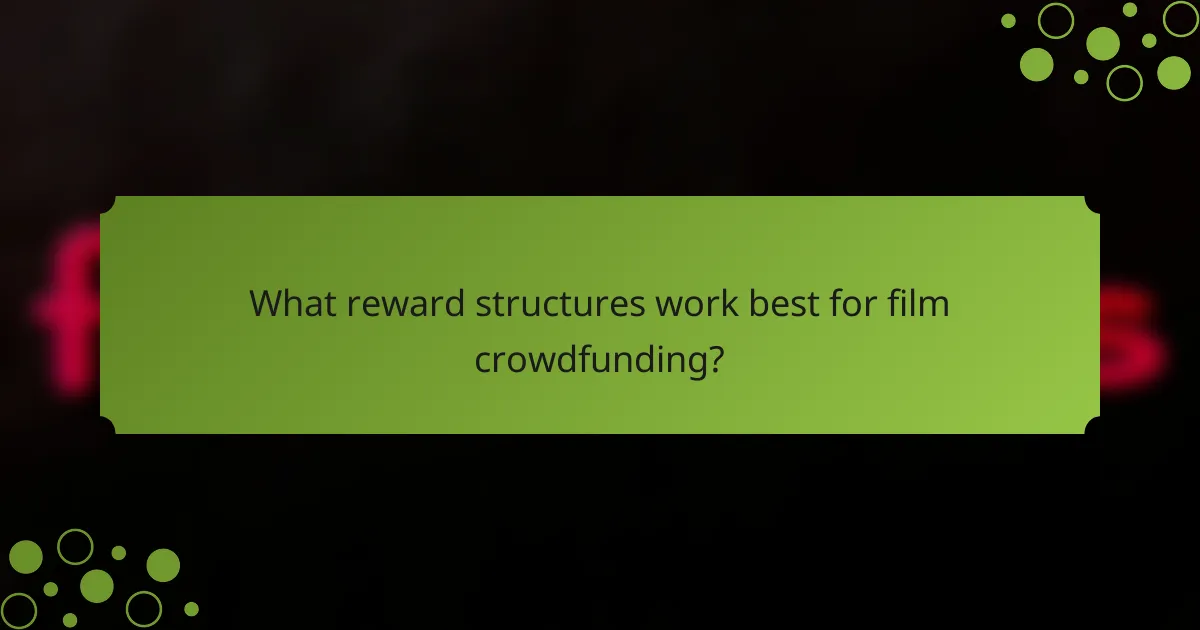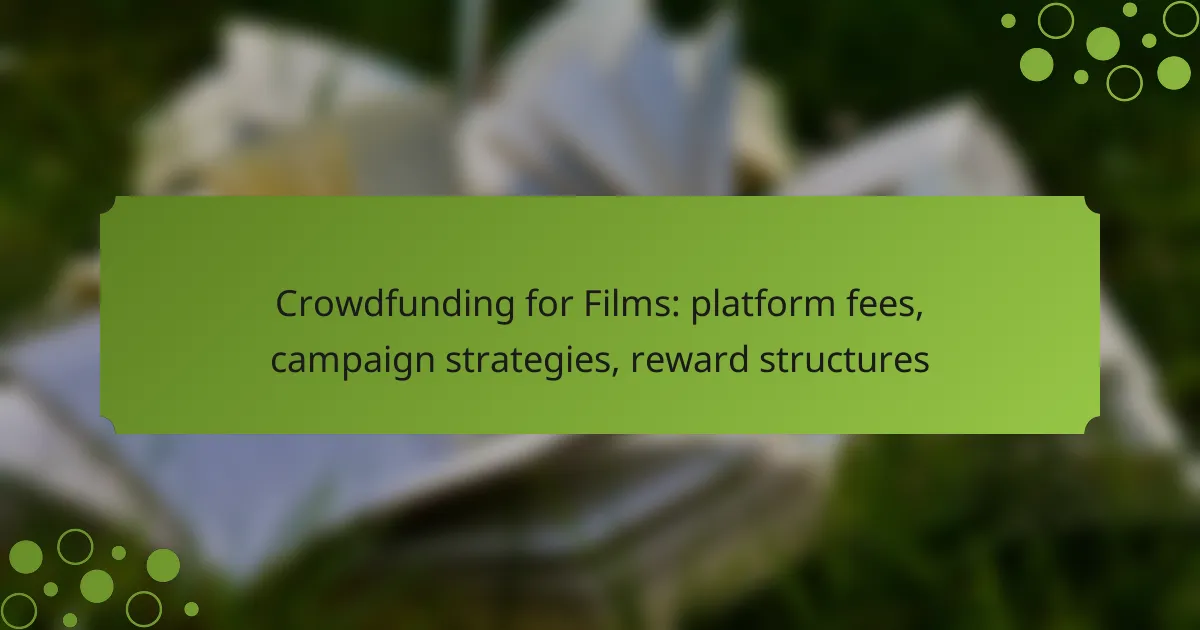Crowdfunding has become a vital tool for filmmakers seeking to finance their projects, with platforms like Kickstarter, Indiegogo, and Seed&Spark offering various features and fee structures. Understanding the typical platform fees, which can range from 5% to 10% of funds raised, is crucial for effective budgeting. To maximize success, filmmakers must develop clear goals, engage potential backers, and implement a robust marketing strategy that resonates with their target audience.

What are the best crowdfunding platforms for films in Australia?
The best crowdfunding platforms for films in Australia include Kickstarter, Indiegogo, Seed&Spark, Pozible, and FilmFreeway. Each platform offers unique features, fee structures, and audience engagement strategies that filmmakers should consider when launching their campaigns.
Kickstarter
Kickstarter is a popular platform for creative projects, including films. It operates on an all-or-nothing funding model, meaning projects must reach their funding goal to receive any money pledged. This can create urgency but also adds pressure to meet the target.
Filmmakers should focus on crafting compelling project descriptions and engaging videos to attract backers. Reward structures often include exclusive merchandise, behind-the-scenes access, or credits in the film, which can incentivize contributions.
Indiegogo
Indiegogo offers both flexible and fixed funding options, allowing filmmakers to choose whether to keep funds raised even if they don’t meet their goal. This flexibility can be beneficial for projects with varying budget needs.
Campaigns on Indiegogo can also benefit from a wider range of reward options, including perks like digital downloads or private screenings. Filmmakers should leverage social media to promote their campaigns and reach potential backers effectively.
Seed&Spark
Seed&Spark is tailored specifically for filmmakers, providing tools for both crowdfunding and audience building. It emphasizes community engagement, allowing filmmakers to connect with their audience throughout the campaign.
In addition to traditional rewards, Seed&Spark offers a unique feature where filmmakers can offer equity in their projects. This platform is ideal for those looking to cultivate a dedicated fan base while raising funds.
Pozible
Pozible is an Australian crowdfunding platform that supports creative projects, including films. It operates on a flexible funding model, allowing filmmakers to keep funds raised even if they don’t meet their goal.
Filmmakers can set various reward tiers, from digital content to exclusive experiences. Engaging with the Australian audience through local marketing strategies can enhance campaign visibility and success.
FilmFreeway
FilmFreeway primarily serves as a submission platform for film festivals but also offers crowdfunding options. It allows filmmakers to raise funds while simultaneously promoting their projects to festival audiences.
Using FilmFreeway can help filmmakers gain exposure and credibility, as many festivals are listed on the platform. Filmmakers should ensure their project stands out with a strong pitch and clear funding goals to attract potential backers.

What are the typical fees associated with film crowdfunding platforms?
Film crowdfunding platforms typically charge fees that can range from around 5% to 10% of the total funds raised. These fees often cover transaction costs and platform maintenance, and it’s essential for filmmakers to factor them into their budgeting and fundraising strategies.
Kickstarter fees
Kickstarter charges a flat fee of 5% on all funds raised. In addition to this, payment processing fees typically range from 3% to 5%, depending on the payment method used. Filmmakers should account for these fees when setting their funding goals to ensure they receive the desired amount after deductions.
Indiegogo fees
Indiegogo offers two funding options: fixed and flexible. For fixed funding, the platform takes a 5% fee, while for flexible funding, the fee is also 5%, but payment processing fees can be around 3% to 5%. Filmmakers should evaluate which option aligns with their project goals, as it affects how funds are managed and distributed.
Seed&Spark fees
Seed&Spark has a unique model where it charges a 5% fee on funds raised, but it also offers a rewards-based system that can help filmmakers build an audience. Additionally, payment processing fees are similar to other platforms, typically around 3% to 5%. This platform is particularly beneficial for filmmakers looking to engage with their audience more directly.
Pozible fees
Pozible charges a 5% fee on successful campaigns, with no fees for unsuccessful ones. Payment processing fees generally range from 3% to 5%. Filmmakers should consider Pozible if they prefer a risk-averse approach, as they only pay fees if their campaign meets its funding goal.

How to create an effective crowdfunding campaign for films?
Creating an effective crowdfunding campaign for films involves setting clear goals, engaging potential backers, and implementing a solid marketing strategy. Success hinges on understanding your audience and effectively communicating your film’s vision and needs.
Setting a realistic funding goal
Establishing a realistic funding goal is crucial for your crowdfunding campaign’s success. Consider your film’s budget, production costs, and any platform fees, which typically range from 5% to 10% of the total funds raised. Aim for a goal that covers essential expenses while remaining achievable to encourage backer confidence.
Research similar projects to gauge typical funding amounts in your genre. A good rule of thumb is to set a goal that reflects your film’s needs but is also within the reach of your target audience’s financial capabilities.
Creating engaging video content
Your campaign video is often the first impression potential backers will have of your project, so it should be compelling and informative. Aim for a length of 2 to 3 minutes, showcasing your film’s concept, key characters, and the unique elements that set it apart. Use high-quality visuals and sound to enhance professionalism.
Include a personal message from the director or lead actors to create a connection with viewers. Highlight what makes your film special and why their support is vital to bringing it to life.
Building a marketing plan
A well-structured marketing plan is essential for driving traffic to your crowdfunding campaign. Start by identifying your target audience and the platforms they frequent. Develop a timeline that outlines when and how you will promote your campaign, including pre-launch teasers, launch day events, and ongoing updates.
Consider creating a press kit with information about your film, key visuals, and contact details to share with media outlets. Engaging with local film communities and industry influencers can also help amplify your reach.
Utilizing social media
Social media is a powerful tool for promoting your crowdfunding campaign and engaging with potential backers. Create dedicated profiles for your film on platforms like Facebook, Instagram, and Twitter to share updates, behind-the-scenes content, and interact with your audience.
Utilize targeted ads to reach specific demographics that align with your film’s themes. Regularly post engaging content, such as polls, Q&A sessions, and sneak peeks, to maintain interest and encourage shares, which can significantly expand your reach.

What reward structures work best for film crowdfunding?
Effective reward structures for film crowdfunding can significantly enhance campaign success. The best approaches often include tiered rewards and exclusive content access, which cater to different backer motivations and encourage higher contributions.
Tiered rewards
Tiered rewards involve creating multiple levels of contributions, each offering different incentives. This strategy allows backers to choose their level of support based on their budget, ranging from low-cost options like digital thank-you notes to high-end perks such as exclusive screenings or producer credits.
When designing tiered rewards, consider offering at least three to five levels to appeal to a broad audience. Ensure that the benefits at each tier are clearly defined and progressively more appealing, which can motivate backers to opt for higher tiers.
A common pitfall is overcomplicating the tiers. Keep it simple and straightforward to avoid confusing potential backers. Clear descriptions and visuals can help illustrate the value of each tier effectively.
Exclusive content access
Exclusive content access rewards provide backers with unique materials related to the film, such as behind-the-scenes footage, early screenings, or special merchandise. This type of reward can create a sense of belonging and investment in the project, encouraging backers to contribute more.
To implement this strategy, consider what exclusive content would resonate most with your audience. For instance, offering a digital download of the film’s score or a limited-edition poster can be enticing. Ensure that the exclusivity is genuine to maintain backer trust and excitement.
Be mindful of the production timeline when promising exclusive content. Delivering on these rewards promptly is crucial to maintaining a positive relationship with your backers and fostering goodwill for future projects.
